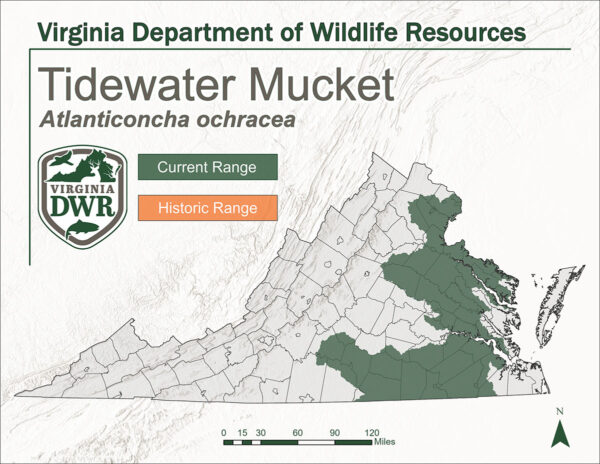Male Tidewater Mucket (top) and female Tidewater Mucket (bottom)
Female Tidewater Mucket encountered during a survey on the Rappahannock River
Tidewater Mucket from the Rappahannock River showing variability in shell coloration
Fact File
Scientific Name: Atlanticoncha ochracea
Classification: Freshwater Mussel, Family Unionidae
Conservation Status:
- Species of Greatest Conservation Need-Tier 3a on the Virginia Wildlife Action Plan
Size: 100 mm
Life Span: 15 years
Identifying Characteristics
- Shell is relatively thin and inflated
- Males and females vary in shell shape, with the posterior end of males being more pointed and females being more truncated
- Both the anterior end and ventral margin is round
- The outer covering of the shell (periostracum) may be gray, green, or olive brown in color
- Rays are fine and indistinct, but may be absent
- The inner portion of the shell (nacre) is white to reddish pink
Habitat
The Tidewater Mucket inhabits small to large coastal rivers, ponds, and lakes in sand, gravel, and mud substrates. It occurs in a variety of flow conditions, but it is most commonly observed in depositional areas with a slow-moving current.
Distribution
The Tidewater Mucket occurs throughout the lower sections of the Chowan, James, Potomac, Rappahannock, Roanoke, and York River basins in Virginia.

Life History
Freshwater mussels have a very unique life cycle. Parasitic larvae, called glochidia, develop in the gills of the female mussel. Once mature, the glochidia are expelled from the gills of the mussel and must attach to the gills of a suitable host fish, where they complete their transformation into a juvenile mussel. They then detach from the fish and begin their free-living existence on the river bottom.
Some freshwater mussels are host-specialists, meaning that metamorphosis can only occur on a limited number of closely related fish species, while others are host-generalists, with the ability to complete their life cycle using many different species. The Tidewater Mucket relies on White Perch (Morone americana) for the successful transformation of its larvae.
Conservation
To combat declines in Tidewater Mucket populations throughout Virginia, the Virginia Fisheries and Aquatic Wildlife Center (VFAWC) has propagated and released over 18,000 juveniles as of 2024. Rangewide status surveys and the continued propagation and augmentation of populations are needed for the conservation of the Tidewater Mucket.
Special Considerations
Freshwater mussels are extremely imperiled organisms. DWR regulates the take and possession of freshwater mussels occurring within the state. It is unlawful to take mussels from any inland waters in the Commonwealth except as provided for in §§ 29.1-418 and 29.1-568 of the Code of Virginia.
Last updated: July 29, 2025
The Virginia Department of Wildlife Resources Species Profile Database serves as a repository of information for Virginia’s fish and wildlife species. The database is managed and curated by the Wildlife Information and Environmental Services (WIES) program. Species profile data, distribution information, and photography is generated by the Virginia Department of Wildlife Resources, State and Federal agencies, Collection Permittees, and other trusted partners. This product is not suitable for legal, engineering, or surveying use. The Virginia Department of Wildlife Resources does not accept responsibility for any missing data, inaccuracies, or other errors which may exist. In accordance with the terms of service for this product, you agree to this disclaimer.

